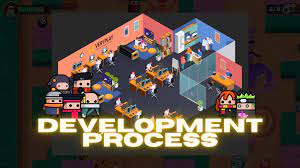I. Introduction
The world of gaming is a captivating realm that combines creativity, technology, and storytelling. This article offers a behind-the-scenes exploration of the intricate process of game development, providing insights into the various stages, challenges, and the collaborative efforts that bring your favorite games to life.
II. The Game Development Lifecycle
a. Conceptualization and Design
- Idea Generation: Game development begins with brainstorming sessions to generate innovative concepts.
- Design Documentation: Developers create detailed design documents outlining the game’s mechanics, characters, and storyline.
b. Pre-Production Phase
- Prototyping: Game designers build prototypes to test gameplay mechanics and refine the user experience.
- Art and Asset Creation: Artists start crafting the visual elements, including characters, environments, and animations.
c. Development Phase
- Coding and Programming: Developers write the code that brings the game to life, implementing features and functionalities.
- Integration of Assets: Programmers integrate art, sound, and other assets into the game engine.
d. Quality Assurance (QA) Testing
- Bug Testing: QA testers identify and report bugs, ensuring a smooth and error-free gaming experience.
- User Testing: Games undergo extensive user testing to gather feedback and make necessary improvements.
e. Polishing and Optimization
- Refinement: Developers polish the game, enhancing graphics, refining gameplay, and addressing user feedback.
- Performance Optimization: Optimizing the game for different platforms and ensuring smooth performance.
f. Post-Production and Launch
- Marketing and Promotion: Game developers engage in marketing strategies to create awareness and anticipation.
- Launch and Distribution: The game is released to the public through various platforms, such as consoles, PC, or mobile devices.
III. The Creative Collaboration
a. Cross-Disciplinary Teams
- Game Designers: Craft the game’s concept, mechanics, and overall experience.
- Programmers: Write the code that implements design elements and ensures functionality.
- Artists: Create visuals, including characters, environments, animations, and special effects.
- Sound Designers: Develop the audio elements, including music, sound effects, and voice acting.
b. Iterative Development Process
- Constant Communication: Regular collaboration and communication among team members to address challenges and refine the game.
- Adaptability: Teams remain flexible, adapting to changes and incorporating feedback throughout the development process.
IV. Technological Advancements in Game Development
a. Graphics and Visual Realism
- High-End Graphics Engines: Advanced graphics engines enable realistic environments, textures, and lighting effects.
- Virtual Reality (VR) and Augmented Reality (AR): Technologies that immerse players in interactive and augmented gaming experiences.
b. Artificial Intelligence (AI) Integration
- Smart NPCs (Non-Playable Characters): AI-driven characters with dynamic behaviors, enhancing the overall gaming experience.
- Adaptive Difficulty Levels: AI adjusts game difficulty based on player performance, providing a personalized challenge.
V. Challenges in Game Development
a. Timeline Pressures
- Strict Deadlines: The demand for timely releases often puts pressure on development teams.
- Adapting to Technological Changes: Keeping up with rapidly evolving technologies requires constant learning and adaptation.
b. Balancing Creativity and Commercial Viability
- Innovation vs. Market Trends: Balancing the need for innovative gameplay with market expectations.
- Monetization Strategies: Incorporating sustainable monetization models without compromising player experience.
VI. The Impact of Player Feedback
a. Community Engagement
- Online Forums and Social Media: Developers actively engage with players to gather feedback and address concerns.
- Regular Updates and Patches: Continuous improvement based on player input enhances the overall gaming experience.
VII. Conclusion
Game development is a multifaceted journey that merges artistic vision with technical prowess. The collaborative efforts of diverse teams, fueled by passion and creativity, result in the immersive and entertaining games enjoyed by millions worldwide. As technology continues to advance, the future of game development promises even more awe-inspiring experiences for players.
FAQs
- Q: What is the role of game designers in the development process?
- A: Game designers conceptualize gameplay, mechanics, and overall user experience, providing the foundation for the development team.
- Q: How does player feedback impact game development?
- A: Player feedback is crucial for continuous improvement. Developers actively engage with the gaming community, incorporating feedback into updates and patches.
- Q: What challenges do game developers face in the industry?
- A: Challenges include strict deadlines, adapting to technological changes, and striking a balance between creativity and commercial viability.
- Q: How do technological advancements impact game development?
- A: High-end graphics engines, virtual reality, augmented reality, and artificial intelligence contribute to creating more immersive and sophisticated gaming experiences.
- Q: What is the iterative development process in game development?
- A: The iterative process involves constant communication and adaptation among cross-disciplinary teams, refining the game throughout its development lifecycle.

